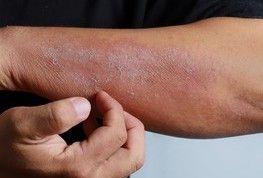News
Article
Contact Dermatitis to Common Wound Care Products Exacerbates Chronic Ulcers
Author(s):
Key Takeaways
- Chronic ulcers can be worsened by contact dermatitis from allergens in wound care products, necessitating updated diagnostic tests.
- Nitrofurazone and fragrance mix II were identified as primary allergens, with longer ulcer duration linked to higher polysensitization rates.
Fifteen of 16 patients with chronic ulcers in a small study had positive patch test to common wound care products.
Credit: Adobe Stock

Staying updated on diagnostic tests for sensitivity in patients with chronic ulcers who may have contact dermatitis (CD) is important for improving outcomes, as most patients in a small study had positive patch test to common wound care products.1
These findings, from a retrospective study, were presented at the 2025 American Academy of Allergy, Asthma, and Immunology/World Allergy Organization Joint Congress, February 28-March 3, in San Diego, California, by Alice De Magalhaes, PhD, Universidade de Sao Paulo, Brazil.
“CD is a chronic inflammatory disease with high prevalence. Barrier defects facilitate exposure to and sensitization by antigens. In the presence of chronic, hard-to-heal wounds, there is the possibility of their own treatment causing or exacerbating them, as observed among patients with chronic ulcers. This study aimed to identify the main substances, potential risk factors, and propose a standardized patch test series for this population,” De Magalhaes and colleagues wrote.1
De Magalhaes and colleagues conducted a retrospective and prospective descriptive study including 15 participants with chronic ulcers (>6 weeks). They performed customized patch tests containing main allergens and most common wound-care product components. They also collected data on sex, age, comorbidities, ulcer duration, treatment, smoking, and previous history of CD.
In the study, most participants were female, older than 56 years, and had an average ulcer duration of 8 years. Among the 15 participants, 1 had no positive patch test results and had the shortest ulcer duration (<6 months). The investigators identified nitrofurazone and fragrance mix II as the main allergens. Other common allergens, in decreasing prevalence, were lanolin, potassium dichromate, propylene glycol, phenylenediamine, chlorhexidine, Peru balsam, benzocaine, clioquinol, neomycin, propolis, and Santalum oil. The investigators noted that most of these substances are included on standard series; however, 6 are not. Patients with longer-lasting ulcers had higher rates of polysensitization.1
“Updating diagnostic tests according to different groups, compounds, and technologies enhances sensitivity. Ours are first Brazilian data. Efforts in prevention and early detection can reduce morbidity and mortality rates, along with social and financial impacts at both individual and collective levels,” De Magalhaes and colleagues concluded.1
Other research on dermatitis, namely early-onset atopic dermatitis, was presented at AAAAI and found that distinct cord-blood DNA methylation (DNAm) patterns are associated with a risk of early-onset atopic dermatitis by 2 years old.2
The study ultimately suggested out of all the identified DNA sites, 180 were the most important for predicting early-onset atopic dermatitis. The poly-CpG score also demonstrated high predictability of early-onset atopic dermatitis with an area under the receiver operator characteristic curve of 93.7% (sensitivity: 84.9%, specificity: 86.3%).2
“Differential cord-blood DNAm is associated with risk of early-onset AD by age 2,” primary investigator Amy Eapen, MD, from Henry Ford Health System, and colleagues concluded.2 “Future studies would include larger, diverse cohorts to assess the validity of our findings.”
REFERENCES
De Magalhaes A, Grecco O, Barros MT, et al. Sensitization profile and contact dermatitis in patients with chronic ulcers: a customized patch test series proposal. Presented at: 2025 AAAAI/WAO Joint Congress, February 28-March 3. Abstract L42.
Eapen, A, Loveless, I, Pan, M, et al. The Impact of the Cord Blood Methylome on Early-Onset Atopic Dermatitis. Late-breaker will be presented at the 2025 AAAAI annual meeting in San Diego from February 28 – March 3.




